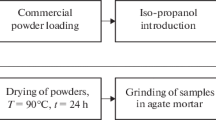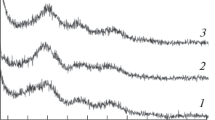Abstract
The effect of mechanical grinding on the structural transformation of titanium dioxide was studied by using several anatase samples prepared from different starting materials and with various particle sizes. Three anatase samples were prepared by hydrolysis of Ti(O·i-C3H7)4, TiCl4, and TiOSO4·2H2O and one is commercial reagent grade anatase. Each of the as-prepared or heat-treated samples (1.0 g) was ground in a mortar of sintered alumina for up to 96 h in air. The stability of brookite synthesized by grinding was examined by heating in air and under hydrothermal pressure. From the relative amount of the phases estimated by the measurement of the integrated intensity of X-ray line profile and of X-ray crystallite size, DTA and TG, IR spectra, and observation by electron microscope, it is concluded that: 1. the transformation proceeds by a consecutive process from anatase to rutile through brookite by grinding; 2. the smaller the initial particle size of anatase, the more stable the intermediate phase of brookite; 3. the very fine crystals of 5∼20 nm of anatase can be grown to 50∼150 nm of rutile by grinding for 96 h; 4. the rate process of the transformation depends on the initial particle size and is independent of the difference in starting materials or of surface adsorbants; 5. an appropriate lattice distortion introduced by grinding is considered to stabilize the brookite phase; and 6. the lattice constant and the density of brookite synthesized by grinding,a 0=0.5447±0.005 nm,b 0=0.9150±0.0005 nm,c 0=0.5141±0.0005 nm, andD x =4.14 g cm−3 agree with those in natural brookite.
Similar content being viewed by others
References
I. Keesman,Z. Anor. Allgem. Chem. 346 (1966) 30.
M. Kiyama, T. Akita, Y. Tsutsumi andT. Takada,Chem. Lett. 1972 (1972) 21.
H. Knoll,Naturwiss. 48 (1961) 44.
Idem, ibid. 50 (1963) 546.
Idem, Angew. Chem. 76 (1964) 592.
T. Kubo, M. Kato, Y. Mitarai, J. Takahashi andK. Ohkura,Kogyo Kagaku Zasshi 66 (1963) 318.
J. Wankova andA. Kochanovska,Krist. und Tech. 1 (1966) 321.
H. P. Klug andL. E. Alexander, “X-ray Diffraction Procedures” (John Wiley and Sons, New York and London, 1974).
J. H. Talbot andE. B. Kempis,Nature 197 (1963) 66.
G. D. Rieck andK. Koopmans,Brit. J. Appl. Phys. 15 (1964) 419.
H. E. Swanson, M. C. Morris, E. H. Evans andL. Ulmer,NBS Monogr. 25 (1964) 57.
Author information
Authors and Affiliations
Rights and permissions
About this article
Cite this article
Suwa, Y., Inagaki, M. & Naka, S. Polymorphic transformation of titanium dioxide by mechanical grinding. J Mater Sci 19, 1397–1405 (1984). https://doi.org/10.1007/BF00563034
Received:
Accepted:
Issue Date:
DOI: https://doi.org/10.1007/BF00563034




